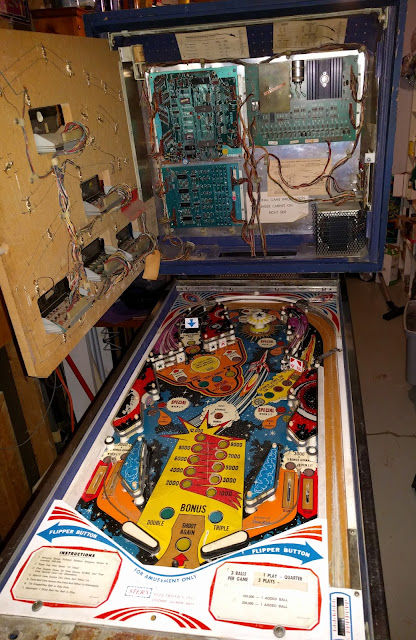Let's all gather to welcome the newest entry in the basement... Stars!
From 1978, it's one of the earliest solid state games, and the 3rd SS from Stern, using their M-100 MPU.
Apollo 13 is Done and Gone and I am so relieved. From one space themed game to another, and to be quite honest I've already gotten more enjoyment out of Stars than A13.
One thing to note is the new preferred method for getting games up and down the difficult turning staircase: removing the playfield.
After trying and failing to arrange for 3 people to help get Apollo 13 up the stairs (it is a very heavy game even with the head off!) I decided to see what it'd take to get the playfield out.
This was inspired by Rollergames, where we quickly realized that once you disconnect the head, the playfield is already disconnected and easily lifts out.
On A13, there were just 3 additional connectors to label and detach. I can only see this being an issue on 90s Williams machines, where they have the brackets+sliders that also secure the playfield in.
So with the playfield removed, A13 was able to come up with just the two of us: playfield, body, head.
The owner came and grabbed it, leaving Stars in the garage, which I got down a few days later another day.
First thing I noticed about Stars is that I hate these ridiculously thin and fragile board connectors.
This game also has the back left leg plate busted, and so the leg only attaches there with bolts on the inside. I am NOT the person to work on this cab and get the plate back. Perhaps the next owner will take a stab at that.
The playfield is super dirty, but the plastics were in great shape. Only the left sling was warped, but I can fix that in the oven.
Backglass is in good shape, and seems to already be sealed with triple thick.
 |
| yeah that might need some fixin |
 |
| that's gonna need some fixin |
 |
| warped plastics? that's a fixin |
 |
| seized solenoid in the school's canoe? you best believe that's a fixin |
Lots of lights out on the playfield.
Needs all new rubbers.
4th player display is non-working.
Casters are seized in to the legs, making levelling nigh impossible.
Let's fix some pinball!
 |
| Mr. Gorbachev: TEAR DOWN THOSE RUBBERS |
 |
| cleaned plastics! |















